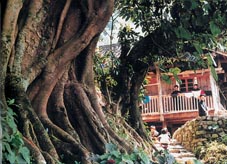
Nanlong is a small village 30 kilometers south of Xingyi City in southern Guizhou Province, Western China. The 360 ancient banyan trees, 108 of them over 100 years old, growing around it have also given rise to the name Banyan Museum. Nanlong is home to 200 Bouyei ethnic minority households whose distinctively tilted houses draw specialists in ethnic architecture to the village for research.
Originating in the Ming Dynasty, Nanlong's entire 2 square kilometers is shaded by banyan trees. To the east of the village is a stream spanned by a banyan root, forming a natural bridge. According to legend, centuries ago a rainstorm caused a flood that threatened to destroy the village. Inhabitants tried to flee, but floodwater prevented them. At that moment A Long, son of the Dragon King, dived into the deluge. He formed a bridge by holding on to a rock on the opposite bank and twining his tail around an ancient banyan
tree. The villagers were able to cross waters over his back. All were saved, but the exhausted A Long was swept away. When the flood subsided villagers found a banyan tree growing in the place where A Long had saved their lives, its root crossing the stream to form a natural bridge. Villagers call it the Yellow Dragon Turned Bridge in his memory.
There are other uniquely shaped trees in the village, one of them the Husband and Wife Tree. Seen from a distance, it appears to have three different types of leaf, but it is actually one camphor tree overlooked by a big banyan that has another pointed leaf banyan growing out of it, five to six meters above ground level.
There are 148 well-preserved traditional tilted Bouyei houses in the village, all strictly constructed and arranged in the Eight Trigram (eight combinations of three lines -- straight, broken, and combined--joined in pairs to form 64
hexagrams, formerly used in divination) formation. A maze of lanes, in which an outsider is likely to get lost, links the houses. It is said the village was so designed to avoid outside encroachment.
Nanlong villagers live according to customs and folkways. The traditional Chinese way of life, where men plough the fields and women weave, still goes on here. Looms and millstones are commonplace, and the clothes villagers wear are woven, dyed and sewn by the local women. When guests come for festivals and major ceremonies, villagers entertain them with performances of local dramas and lilting songs.
Other Scenic Spots near Xingyi City
1. Maling River Valley
A national key scenic spot, this is a rift valley with unique geomorphologic structure, 100 kilometers long, and 200 to 400 meters deep, framed by waterfalls on either side.
2. Ten Thousand Peak Forest
"There are countless mountain peaks on earth, but only the peaks here stand together to form peak forests. Stretching for thousands of kilometers, Ten Thousand Peak Forest is a natural wonder in Southwest China," so wrote ancient Chinese geologist Xu Xiake in his travel journal. He divided the peak forests there into five types according to their shapes. They are the Sword Peak Forest, Dragon Group Peak Forest, Luohan (Buddhist Arhat) Peak Forest, Piled Hats Peak Forest and Battle Formation Peak Forest. Each type has its own characteristics and all combine to form a splendid karst vista.
3. Ten Thousand Peak Lake
Ten Thousand Peak Lake is an artificial lake 144 kilometers long, covering an area of 176 square kilometers, with a water storage capacity of 10.2 billion cubic meters. Bounded by mountains on all sides, it is called the Ten Thousand Peak Lake, and is one of the five biggest freshwater lakes in China.
Local Specialties
There are many tasty traditional snacks in Xingyi, the most famous Gangzi Noodles and Mutton with Bean Noodles. Guizhou Good Liquor, Miao embroidered ties, and Miao and Bouyei costumes and ornaments make perfect souvenirs and gifts.
The Cha-Bai Singing Festival
Local Bouyei people in Xingyi City, Guizhou Province celebrate the Cha-Bai Singing Festival from the 21st to the 23rd day of the sixth lunar month. During the festival, tens of thousands of people come from neighboring Yunnan Province and Guangxi Zhuang Autonomous Region to participate.
There is another legend about the origins of the festival. Once a young boy Chalang and a beautiful girl Baimei fell deeply in love. Baimei went to the mountain to cut firewood and was attacked by a tiger. Chalang killed the tiger and confessed his love for Baimei. A local official was infatuated with Baimei's beauty, but none of his cajolery could win her heart. In the end he murdered Chalang and took Baimei to his home. In sore anguish, she set fire to the official's family mansion and died in the flames. To commemorate these lovers, the local people named the site Cha-Bai Village. Since then, they hold a festival on the date of Baimei's death every year on the spot where Chalang killed the tiger.
Before the festival, all local families wash their clothes and bedding and hang them in the village, symbolizing the purity of love. During the festival, everyone heads for Cha-Bai Village in groups, and young people wear their best festive clothes and bring love tokens, in the hope of finding a lover as true and faithful as Chalang or Baimei.
A singing competition is the main event. In the daytime, participants sing on the competition ground, and in the evening move to the local residents' courtyards and rooms. The hosts cook colored glutinous rice, heat rice wine, which it is the Bouyei custom to serve guests. They also serve soup to visiting friends and relatives. It is said that this soup was originally cooked from the meat of the tiger killed by Chalang. These days it is made from pork and mountain spring water.
(China Today by Luo Yuanjun December 3, 2003)
|

